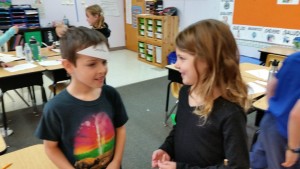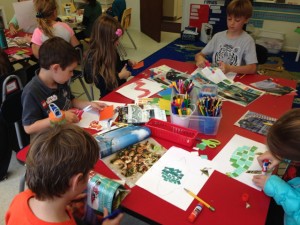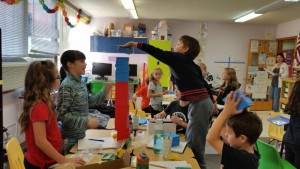Language Arts
This week we learned about helping verbs/ verbos auxiliares. We looked through our new reader and in our anthology story, Rugby y Rosy for examples of these. (Ms. Marci also discussed what helping verbs look like in English.) To help with identification of these we worked on a fall leaf art project where each student chose a different verb. These are on our hallway display.
Students received their 4th reading book this week. They will receive their “Reading with a purpose” worksheet on Monday, due on 10/16. In this book students will be looking for helping verbs, words spelled with Z, and detailed sentences.
Spelling/ ortografia (Our Spelling test will be Tuesday 10/13)
cruzar cruzó cruzando empezó manzanas azul comenzó tazón mudanza vez cabeza pedazos voz martillazos belleza
Math
This week we began our third unit: Addition up to 10,000. The focus is on understanding addition as it relates to place value. Students will be expected to be able to rename numbers (3,000 = two thousands and ten hundreds). The emphasis is on building procedural knowledge with deep understanding. Fluency is expected only within 1000.
We played a great game, Suma Mil, to practice our quick mental addition up to 1000. This was a great activity to combine our last unit, Mental Math, and our new unit.
Social Studies
We learned about the Roman Republic in class this week. We learned how the government during this time was different from the period when the Etruscan kings ruled and we compared it to our current form of government. The students talked about how the different classes (Plebeians, Patricians, and Slaves) interacted with one another and how and why the laws were different for each class. We played a “Who am I” game where students had to figure out what person was taped to their forehead by asking yes and no questions. The class loved this game! We worked on a map to identify the Strait of Gibraltar, the Sea of Marmara, and the Mediterranean Sea. On Thursday the class went to the computer lab and explored the BBC site on Ancient Rome. They were able to play games, read about different events, view photographs, look at a timeline and answer questions.
 Science
Science
We continued to work on reptiles this week in our science unit. Students did a webbing to identify the main characteristics, drew a reptile of their choosing and filled in their reptile column on their classification chart. On Thursday we began learning about birds. Miss Lisa shared with the class an Emu egg and a Robin’s nest.
English Spelling/Writing
The class began writing responses to both social studies and science review questions this week and then we were able to share some of these writings with the class. This allows everyone to reflect on what we have read in our lessons and practice some of our writing skills. We worked on restating the question in a topic sentence. We did not have a spelling test this week since it was a short week, both the spelling test and the sort activities will be turned in next Friday, Oct. 16. The students were given a new sort activities list with some added activities. Keep in mind that a 2 point activity should take 5 to 10 minutes, a 5 point activity should be around 15 minutes and a 10 point activity would take 20 to 30 minutes.
 Art
Art
The 2nd and 3rd graders started a Roman Mosaic project in art. We looked at a couple ancient Roman and Byzantine mosaics, and the students learned that the stone or glass pieces used in mosaics are called tesserae. The students are using magazines and catalogues to cut out paper tesserae for their mosaics of amphibians or reptiles. They’re off to a great start!
Music
We learned a bilingual song, “Somos el barco” and reviewed “Una paloma blanca.” Both songs were originally written with words in both English and Spanish, and Sr. Kit is practicing to sing them with kids in Cuba.

